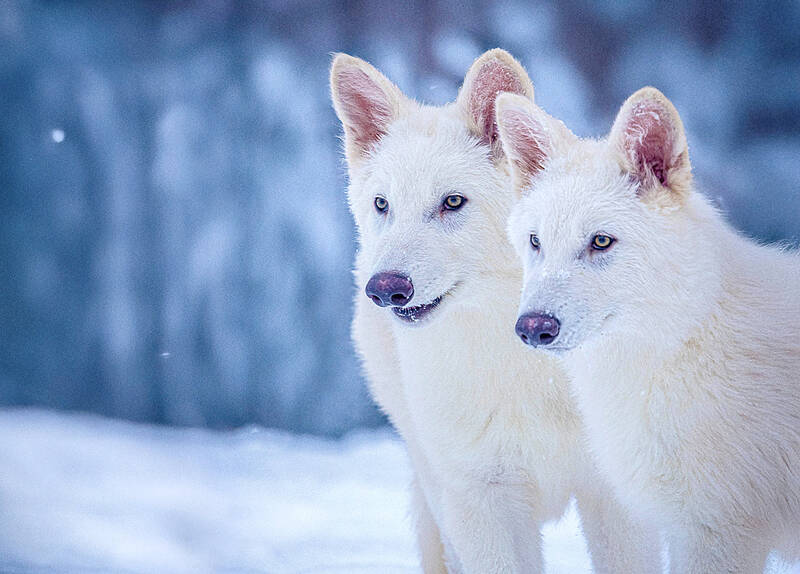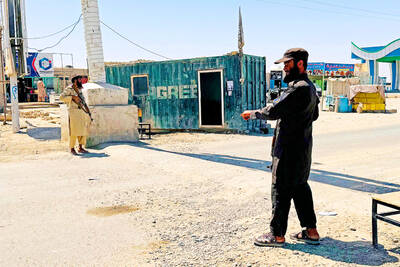Three genetically engineered wolves that may resemble extinct dire wolves are trotting, sleeping and howling in an undisclosed secure location in the US, according to a company that aims to bring back lost species.
The wolf pups, which range in age from three to six months, have long white hair, muscular jaws and already weigh in at about 36kg — on track to reach 64kg at maturity, researchers at Colossal Biosciences said on Monday.
Dire wolves, which went extinct more than 10,000 years ago, are much larger than gray wolves, their closest living relatives today.

Photo: Colossal Biosciences via AP
Independent scientists said this latest effort does not mean dire wolves are coming back to North American grasslands any time soon.
“All you can do now is make something look superficially like something else” — not fully revive extinct species, said Vincent Lynch, a biologist at the University at Buffalo who was not involved in the research.
Colossal scientists learned about specific traits that dire wolves possessed by examining ancient DNA from fossils. The researchers studied a 13,000-year-old dire wolf tooth unearthed in Ohio and a 72,000-year-old skull fragment found in Idaho, both part of natural history museum collections.
Then the scientists took blood cells from a living gray wolf and used CRISPR to genetically modify them in 20 different sites, Colossal chief scientist Beth Shapiro said.
They transferred that genetic material to an egg cell from a domestic dog. When ready, embryos were transferred to surrogates, also domestic dogs, and 62 days later the genetically engineered pups were born.
Colossal has previously announced similar projects to genetically alter cells from living species to create animals resembling extinct woolly mammoths, dodos and others.
Although the pups may physically resemble young dire wolves, “what they will probably never learn is the finishing move of how to kill a giant elk or a big deer,” because they will not have opportunities to watch and learn from wild dire wolf parents, Colossal chief animal care expert Matt James said.
Colossal also reported that it had cloned four red wolves using blood drawn from wild wolves of the southeastern US’ critically endangered red wolf population. The aim is to bring more genetic diversity into the small population of captive red wolves, which scientists are using to breed and help save the species.
The technology might have broader application for conservation of other species because it is less invasive than other techniques to clone animals, said Christopher Preston, a wildlife expert at the University of Montana who was not involved in the research, but it still requires a wild wolf to be sedated for a blood draw and that is no simple feat.
Colossal chief executive Ben Lamm said the team met with officials from the US Department of the Interior late last month about the project.
US Secretary of the Interior Doug Burgum praised the work on Monday on social media as a “thrilling new era of scientific wonder,” even as outside scientists said there are limitations to restoring the past.
“Whatever ecological function the dire wolf performed before it went extinct, it can’t perform those functions” on today’s existing landscapes, Lynch said.

‘EYE FOR AN EYE’: Two of the men were shot by a male relative of the victims, whose families turned down the opportunity to offer them amnesty, the Supreme Court said Four men were yesterday publicly executed in Afghanistan, the Supreme Court said, the highest number of executions to be carried out in one day since the Taliban’s return to power. The executions in three separate provinces brought to 10 the number of men publicly put to death since 2021, according to an Agence France-Presse tally. Public executions were common during the Taliban’s first rule from 1996 to 2001, with most of them carried out publicly in sports stadiums. Two men were shot around six or seven times by a male relative of the victims in front of spectators in Qala-i-Naw, the center

Incumbent Ecuadoran President Daniel Noboa on Sunday claimed a runaway victory in the nation’s presidential election, after voters endorsed the young leader’s “iron fist” approach to rampant cartel violence. With more than 90 percent of the votes counted, the National Election Council said Noboa had an unassailable 12-point lead over his leftist rival Luisa Gonzalez. Official results showed Noboa with 56 percent of the vote, against Gonzalez’s 44 percent — a far bigger winning margin than expected after a virtual tie in the first round. Speaking to jubilant supporters in his hometown of Olon, the 37-year-old president claimed a “historic victory.” “A huge hug

Canadian Prime Minister Mark Carney is leaning into his banking background as his country fights a trade war with the US, but his financial ties have also made him a target for conspiracy theories. Incorporating tropes familiar to followers of the far-right QAnon movement, conspiratorial social media posts about the Liberal leader have surged ahead of the country’s April 28 election. Posts range from false claims he recited a “satanic chant” at a campaign event to artificial intelligence (AI)-generated images of him in a pool with convicted sex offender Jeffrey Epstein. “He’s the ideal person to be targeted here, for sure, due to

DISPUTE: Beijing seeks global support against Trump’s tariffs, but many governments remain hesitant to align, including India, ASEAN countries and Australia China is reaching out to other nations as the US layers on more tariffs, in what appears to be an attempt by Beijing to form a united front to compel Washington to retreat. Days into the effort, it is meeting only partial success from countries unwilling to ally with the main target of US President Donald Trump’s trade war. Facing the cratering of global markets, Trump on Wednesday backed off his tariffs on most nations for 90 days, saying countries were lining up to negotiate more favorable conditions. China has refused to seek talks, saying the US was insincere and that it